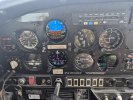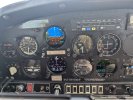Sunday Puncher
Filing Flight Plan
- Joined
- Jul 10, 2024
- Messages
- 7
- Display Name
Display name:
Ben Burns
Alright time for stump the chumps! First of all I am brand new here (and also to aviation) so thank you all for your time and energy, and ideas.
I have a 79' Grumman AA5A Cheetah with an 0320-E2G my issue is as follows. I have noticed lately a slow drop in RPM's during cruise flight. I am up leveled off, trimmed out cruising at lets say 2350 rpm and then the engine will slowly and smoothly drop down to 2290 or 2270 even.... I say slowly, it takes maybe 10-15 seconds or maybe even slightly longer for this to happen. I noticed first by a slow loss of altitude as I am now not trimmed for the reduced power. Started paying attention more, added power back in and resumed normal cruise... then some time later... maybe a minute or two it would "recover" and climb back up in RPM, so that now I was higher than before.
Through some experimentation, If I do not adjust throttle during this, it will follow roughly the same pattern as I just described, but recover to almost where it started (I say almost bc sometimes I swear it goes slightly higher than it was previsouly set at). It never runs rough, or coughs at all, its always a very smooth process. Usually once it happens it will continue to happen intermintenly for the rest of the flight. I have an engine moniter and it does not appear to be affecting the engine temps, or at least I have not noticed it.
It seems to happen after engine is warm and been running for a while but not always. More background on engine, it has one an electroair electronic mag on the right side of firewall and a traditional magneto on the left. During runup and mag test the traditional mag tests within spec and I get a very consistent 60-70 RPM drop. I have a digitial Tach so the exactness of the RPM's I have quoted are accurate. I do not know how many hours on are that mag either but could find out. I beleive the electroair was put on when the high compression cylinders were added and has a TT of around 350.
Other simple things I have checked throttle friction lock to see if it was slowing working its way out, it is not.
Any other questions about this please ask I will asnwer as best I can. I mention things about the mags because that seemed the most likely culprit.... but again I am very new. Thank you all in advance and I am currious to hear what you think.
I have a 79' Grumman AA5A Cheetah with an 0320-E2G my issue is as follows. I have noticed lately a slow drop in RPM's during cruise flight. I am up leveled off, trimmed out cruising at lets say 2350 rpm and then the engine will slowly and smoothly drop down to 2290 or 2270 even.... I say slowly, it takes maybe 10-15 seconds or maybe even slightly longer for this to happen. I noticed first by a slow loss of altitude as I am now not trimmed for the reduced power. Started paying attention more, added power back in and resumed normal cruise... then some time later... maybe a minute or two it would "recover" and climb back up in RPM, so that now I was higher than before.
Through some experimentation, If I do not adjust throttle during this, it will follow roughly the same pattern as I just described, but recover to almost where it started (I say almost bc sometimes I swear it goes slightly higher than it was previsouly set at). It never runs rough, or coughs at all, its always a very smooth process. Usually once it happens it will continue to happen intermintenly for the rest of the flight. I have an engine moniter and it does not appear to be affecting the engine temps, or at least I have not noticed it.
It seems to happen after engine is warm and been running for a while but not always. More background on engine, it has one an electroair electronic mag on the right side of firewall and a traditional magneto on the left. During runup and mag test the traditional mag tests within spec and I get a very consistent 60-70 RPM drop. I have a digitial Tach so the exactness of the RPM's I have quoted are accurate. I do not know how many hours on are that mag either but could find out. I beleive the electroair was put on when the high compression cylinders were added and has a TT of around 350.
Other simple things I have checked throttle friction lock to see if it was slowing working its way out, it is not.
Any other questions about this please ask I will asnwer as best I can. I mention things about the mags because that seemed the most likely culprit.... but again I am very new. Thank you all in advance and I am currious to hear what you think.



